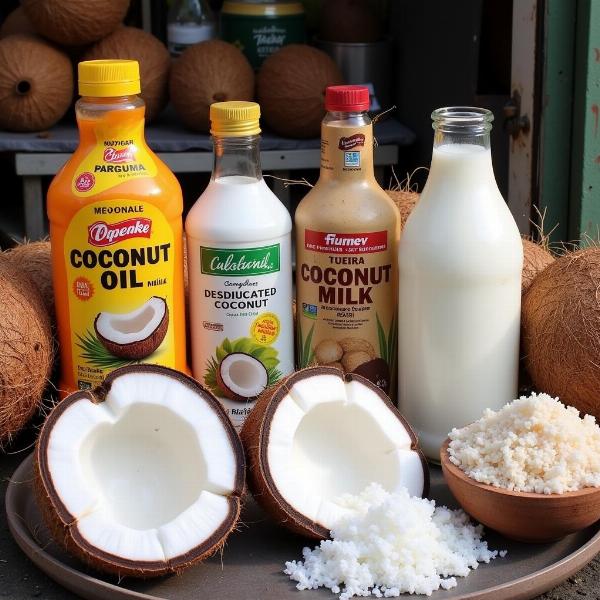Understanding the meaning of “coco” in Hindi can be tricky, as it doesn’t have a direct, single translation. The meaning depends heavily on the context. It can refer to the coconut fruit, a term of endearment, or even slang. This article explores the various meanings of “coco” in Hindi, its cultural significance, and common usage.
Decoding “Coco”: From Fruit to Endearment
The most common meaning of “coco” in Hindi relates to the coconut, a ubiquitous fruit in India. While the formal Hindi word for coconut is “nariyal” (नारियल), “coco” is often used informally, especially in regions with a strong influence of Dravidian languages like Tamil and Malayalam, where variations like “kobbari” are used. “Coco” is easier to pronounce and has become a popular alternative. This informal usage has permeated into Hindi through cultural exchange and media.
“Coco” can also be a term of endearment, similar to “honey” or “dear” in English. It’s often used within families and among close friends, particularly towards children. This usage reflects the sweetness and nourishing nature of coconut, drawing parallels to the affection and care felt for loved ones.
Beyond the Basics: Exploring Contextual Meanings
While “coco” primarily refers to the coconut fruit or a term of endearment, it can sometimes have other nuanced meanings. For instance, in certain dialects or within specific communities, it might be used as slang with varying connotations. It is important to consider the specific context to accurately decipher the intended meaning.
 Coconut Products in India
Coconut Products in India
Coco in Indian Culture: A Symbol of Prosperity and Purity
The coconut holds a significant place in Indian culture and traditions. It’s considered a sacred fruit and is often used in religious ceremonies and rituals. The coconut is seen as a symbol of prosperity, purity, and auspiciousness. It is commonly offered to deities and is broken during important occasions as a gesture of good luck. From kheer meaning in hindi to various curries, the coconut’s culinary versatility is also deeply ingrained in Indian cuisine.
Coco’s Culinary Journey: From Coconut Milk to Coconut Chutney
The coconut’s culinary applications are vast and diverse in India. From the refreshing coconut water to the rich coconut milk used in curries and desserts like kheer meaning in hindi, the coconut’s presence is widespread. Desiccated coconut is used in sweets and savory dishes, while coconut oil is a staple in many households. Even the coconut shell is repurposed, often used as a vessel or for crafting decorative items. Don’t forget the ever-popular chatni meaning in hindi, a flavorful condiment that often features coconut as a key ingredient. Many South Indian temples use coconut in offerings and rituals, showcasing its spiritual significance. Learn more about temple in hindi meaning on our site.
Coco vs. Nariyal: Navigating the Nuances
While “coco” is commonly used, “nariyal” remains the formal and widely accepted Hindi word for coconut. In formal settings or written communication, “nariyal” is the preferred term. However, in everyday conversations and informal contexts, “coco” is widely understood and accepted. Understanding the difference between these two terms helps in effectively communicating in different situations. For example, if you are looking for what curry meaning in hindi and its ingredients, you would likely use “nariyal” in a formal recipe or “coco” in a casual conversation.
Frequently Asked Questions (FAQ)
- Is “coco” an official Hindi word for coconut? No, the formal Hindi word for coconut is “nariyal.” “Coco” is an informal term often used in colloquial language.
- Why is coconut so important in Indian culture? Coconut is considered a sacred fruit, symbolizing prosperity and purity. It’s used in religious ceremonies, rituals, and various culinary preparations.
- What are some popular dishes that use coconut? Coconut milk is used in curries and desserts, desiccated coconut in sweets and savory dishes, and coconut oil is a common cooking medium. Chatni meaning in hindi and kheer meaning in hindi are just two examples.
- Where does the term “coco” come from? It’s likely derived from Dravidian languages and has become integrated into Hindi through cultural exchange.
- Can “coco” have any other meanings besides coconut? Yes, it can be a term of endearment or even slang, depending on the context and region.
- What is the significance of offering coconuts in temples? Coconuts are considered sacred offerings to deities, representing devotion and seeking blessings. Explore temple in hindi meaning for more details.
- Where can I find more information about coconut groves in Hindi? Learn about coconut grove meaning in hindi on our dedicated page.
Conclusion: Understanding the Multifaceted Meaning of “Coco”
From its culinary applications to its cultural significance, “coco” represents more than just a fruit in India. Understanding its various meanings and nuances is key to appreciating its role in Indian language, culture, and traditions. Whether you are discussing recipes, exploring cultural practices, or simply using a term of endearment, knowing the context is essential for interpreting the meaning of “coco” correctly.
Meaning-Hindi.in is your trusted partner for all your Hindi translation needs. We specialize in a wide range of translation services, from business and legal documents to technical manuals, website localization, and educational materials. Our expert team ensures accurate and culturally sensitive translations, delivering high-quality services for diverse clients. Contact us at [email protected] or call us at +91 11-4502-7584. Meaning-Hindi.in is committed to bridging language barriers and facilitating effective communication.